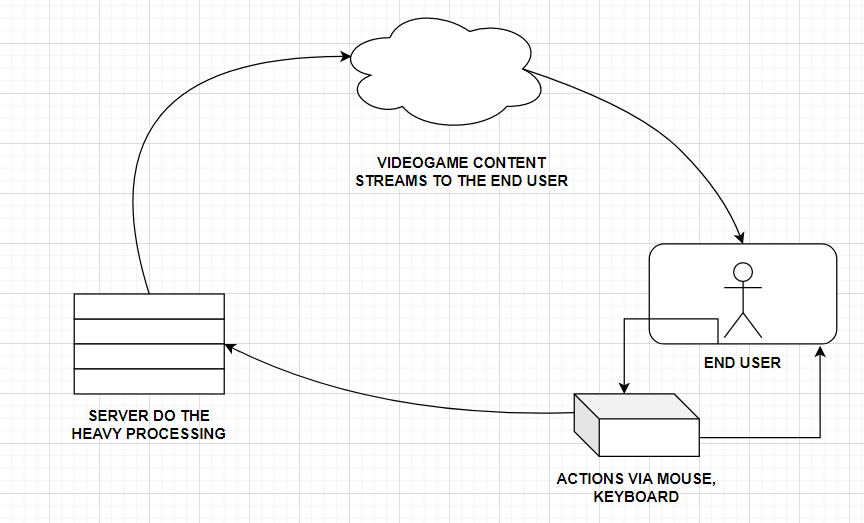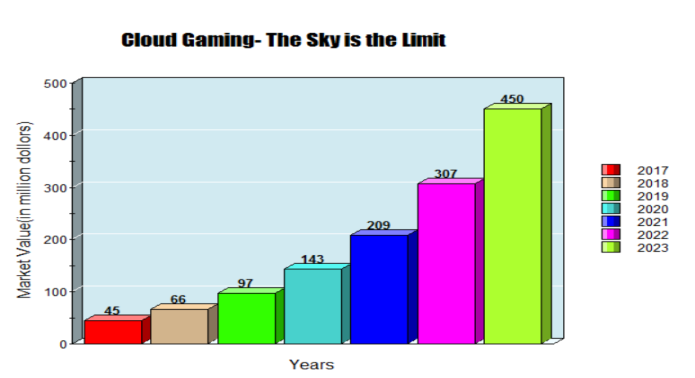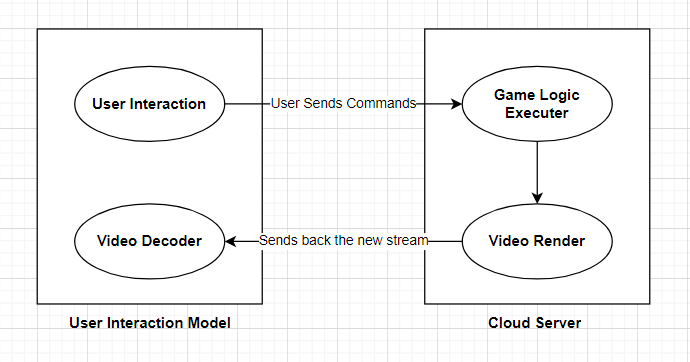Ijraset Journal For Research in Applied Science and Engineering Technology
- Home / Ijraset
- On This Page
- Abstract
- Introduction
- Conclusion
- References
- Copyright
Introduction to Cloud Gaming
Authors: Rajiv Tulsyan, Pranjal Shukla, Anshul Bhardwaj, Tushar Singh, Jatin Verma
DOI Link: https://doi.org/10.22214/ijraset.2024.64672
Certificate: View Certificate
Abstract
Cloud Gaming can be defined as a technology that enables gamers to play video games using cloud-based servers and infrastructure, rather than relying on local hardware for processing and rendering game graphics. In cloud gaming, the games are streamed to the player\'s device with the help of the internet, allowing them to play high-quality games without needing to own a high-end gaming console or PC. The solution helps people to play games on their computers regardless of their own system as their gaming needs are met with the help of good enough customer service in the cloud. It also helps to overcome the problems of traditional games such as conflict and mobility. In this article, we will take a look at various aspects of Cloud Gaming System (CGS) to explain the many advantages and capabilities this concept has.
Introduction
I. INTRODUCTION
Cloud gaming is a relatively new technology that has been rapidly gaining popularity in recent years. This technology enables gamers to play high-quality video games on a wide range of devices, including smartphones, tablets, laptops, and smart TVs, without the need for expensive gaming consoles or high-end PCs. The concept behind cloud gaming is simple - the games are hosted on remote servers, and the video and audio streams are delivered to the user's device over the internet in real-time[1]. This allows gamers to play high-end games on devices that might not have the necessary processing power or graphics capabilities to run the games locally. Computer games are graphics intensive and require new hardware that can handle these high-end demands. This restriction affects every single player of the game who has to change their hardware every time a new and incompatible version of the game is released[2]. Also, there are hardware and software incompatibilities that require more time to set up the game. Cloud gaming allows users to access hardware in cloud systems, eliminating the need to reconfigure their hardware, install games, and worry about hardware/software incompatibilities.

Fig-1 Flowchart of Cloud Gaming
Another significant advantage is that the game can be played on any system such as PC, mobile devices and even TVs with set-top boxes if you have a good enough internet connection [3]. Cloud Computing is also different from online gaming, as the old way of online gaming also takes advantage of remote resources in the cloud, but the execution of game logic is done only on the client side, while servers are available to manage consistency between states. various games that are played on it. While in a cloud game architecture, the execution of the program logic is done on the server side. The benefits of cloud gaming are numerous. For one, it is highly accessible - gamers can play their favorite games from anywhere with an internet connection, whether at home or on-the-go. Additionally, cloud gaming eliminates the need for expensive hardware upgrades or purchasing new consoles, making it a more cost-effective option for many gamers [5].
Cloud gaming services have been offered by major tech companies such as Google, Microsoft, and Nvidia, among others. These services typically require a subscription fee access to a library of games that users can stream to their devices.
However, cloud gaming has its own challenges. One of the biggest obstacles is latency, as the time it takes for the data to travel from the server to the user's device can impact the gameplay experience [4]. Security and privacy concerns are also an issue, as users are often required to share sensitive information with the cloud gaming service providers. Despite these challenges, cloud gaming is a rapidly growing market, with an increasing number of gamers opting for cloud-based gaming over traditional console or PC gaming. As such, it is an exciting and rapidly evolving field that holds great potential for the future of gaming [6].

Fig-2 History of Gaming
II. LITERATURE REVIEW
- Chun-Ying-Huang et al. proposed a model on “Gaming anywhere: an open cloud gaming system” in which he proposed a complete cloud gaming system for windows, android, OS and all the operating systems. It provided high responsiveness and video quality.
- Ryan Shea et al. proposed a model for cloud gaming mainly focusing on the architecture and ways of improving performance. They conducted systematic analysis and highlighted the uniqueness of their framework designs and also measured the performances with different types of games.
- Kuan-Ta Chen et al. research on the quality of cloud gaming system services in which he tried to find out which cloud gaming system delivers the best user-perceived quality of services (QoS). He proposed the measurement techniques for measuring the QoS.
- Wei Cai et al. proposed research doing a survey on cloud gaming and the future of computer games. In his paper, he surveyed the recent cloud gaming researches from numerous aspects, spanning over cloud gaming platforms, optimization techniques, and commercial cloud gaming techniques.
- Kuan-Ta Chen et al. proposed research focusing on the measurement of latency of cloud gaming systems i.e, real-timeliness. He analyzed the latency of two cloud gaming platforms namely OnLive and StreamMyGame and gave the stream latency of these platforms for real-time cloud gaming.
- M. Manzano et al. proposed research on cloud gaming. The model focused on the studying of the impact of cloud gaming on the access network load, network traffic analysis was done. He compared two gaming platforms, one online and the other one cloud and revealed their differences in terms of traffic, packet size distribution, etc.
- Chun-Ying Huang et al. from a study on GamingAnywhere termed as the first open-source cloud gaming system which had features like hogh extensibility, portability, and reconfigurability for operating systems including windows, android, OS X, Linux, etc. Results showed that the platform is much more efficient, scalable, adaptable to network conditions and has a higher responsiveness and video quality.
- Omar Soliman et al. proposed a study on the issue and challenges related to mobile cloud gaming. He focused on delivery paradigm also called as gaming as a service (GaaS) which is used to stream computer games across internet and also mentioned the technical, ethical and legal issues regarding it.
- Wei Cai et al. proposed research in which he gave his point of view regarding the topic of the future of cloud gaming. In his paper, he classified cloud gaming platforms into three types depending on how games are integrated with the platforms. He shared numerous visions of himself regarding cloud gaming technologies, business models, social impact, in the format of forecast.
- Arto Ojala et al. proposed a case study on the topic of developing cloud businesses in which he discussed about numerous ways of developing and operating cloud businesses in the global market mainly focusing on small firms for their existence in the market traditionally dominated by the multinational cooperations.
- Gazi Karam Illahi et al. proposed research on cloud gaming with foveated video encoding in which he wrote about how foveated video encoding reduces the bandwidth requirement taking use of the non-uniform acuity of human visual system by knowing where it is looking for enhancing the resolution. It was based on a real-time eye tracker.
A. Technical Aspects of Cloud Gaming
Several studies have focused on the technical aspects of cloud gaming, such as network latency, bandwidth, and video encoding. According to a study by Liu et al. (2018), network latency is a critical factor affecting cloud gaming performance. The study proposed a new predictive method for cloud gaming latency, which can improve the user experience. Another study by Teng et al. (2019) focused on video encoding in cloud gaming, and proposed a new algorithm for real-time video encoding that can reduce latency and improve image quality.
B. User Experience in Cloud Gaming
User experience is a crucial factor in the success of cloud gaming [8]. Several studies have examined the user experience of cloud gaming from various perspectives. According to a study by Cai et al. (2018), the perceived latency in cloud gaming is a critical factor affecting user experience]. The study proposed a new approach to reducing perceived latency by utilizing a prediction model. Another study by Liu et al. (2019) focused on the effect of network delay on user experience in cloud gaming. The study proposed a new approach to improving user experience by dynamically adjusting video quality based on network delay [7].
C. Business and Economic Aspects of Cloud Gaming
Cloud gaming has significant potential for generating revenue in the gaming industry. Several studies have examined the business and economic aspects of cloud gaming. According to a study by Zhang et al. (2018), cloud gaming can reduce the cost of game distribution and increase revenue for game developers. The study proposed a new pricing model for cloud gaming that can benefit both game developers and users. Another study by Wang et al. (2019) focused on the impact of cloud gaming on traditional gaming platforms, such as consoles and PCs. The study found that cloud gaming can complement traditional gaming platforms and create new revenue streams for game companies.
D. Security and Privacy in Cloud Gaming
Security and privacy are significant concerns in cloud gaming, as users' personal information and game data are stored on remote servers[9]. Several studies have examined the security and privacy issues in cloud gaming. According to a study by Li et al. (2019), cloud gaming platforms face various security threats, such as data breaches and distributed denial-of-service (DDoS) attacks. The study proposed a new security framework for cloud gaming that can detect and mitigate security threats. Another study by Chen et al. (2020) focused on the privacy concerns in cloud gaming and proposed a new privacy-preserving mechanism that can protect users' personal information. In conclusion, cloud gaming is an emerging technology that has attracted significant research and development efforts. Technical aspects, user experience, business and economic aspects, and security and privacy are some of the key areas that have been examined in cloud gaming research[11]. The findings of these studies can provide insights into the development and optimization of cloud gaming platforms, as well as the formulation of policies and regulations for cloud gaming.

Fig-3 Market Value of Cloud Gaming
Cloud gaming relies on servers to run game services instead of powerful PCs. With video game streaming from the cloud, players can access their games from anywhere on any device, from phones, TVs, and PCs. And from a business point of view, moving games to the cloud can provide scalability and cost efficiency with greater engagement and higher returns for investors [14]. In 2017, Statista estimated that cloud computing was worth around $45 million worldwide. In just six years, they estimate that cloud computing will be worth around $450 million. This equates to a 900% increase between 2017 and 2023[10]. The next few years will be a critical time for the industry to move forward. Microsoft, Amazon, and Nvidia are all developing their own cloud gaming services. After Google's announcement, Walmart's cloud gaming option could also work.

Fig-4 General framework of a CGS
Methodology in cloud gaming refers to the technical and operational processes involved in delivering high-quality video games to users over the internet. This involves various elements such as server-side technologies, client-side technologies, network infrastructure, and compression and video streaming technologies.
- Server-side Technologies: Cloud gaming requires powerful servers to host the game and deliver it to the user's device [13]. These servers typically use high-end graphics cards and processors to ensure that the game runs smoothly.
- Client-side Technologies: The user's device, such as a smartphone or a laptop, must be able to receive and render the game stream from the server. This requires specialized client-side software or hardware, such as a cloud gaming app or a smart TV with built-in cloud gaming capabilities.
- Network Infrastructure: The network infrastructure used to deliver the game stream is critical to the overall gaming experience. Cloud gaming requires a high-speed and low-latency internet connection to ensure that the gameplay is smooth and responsive
- Compression and Video Streaming Technologies: To deliver high-quality video game streams over the internet, cloud gaming providers use advanced compression and video streaming technologies. These technologies compress the game data and video streams to reduce the amount of data that needs to be transmitted over the internet, while still maintaining high-quality video and audio
- Latency Reduction Techniques: One of the biggest challenges in cloud gaming is latency, which can cause lag and other gameplay issues. To combat this, cloud gaming providers use various techniques to reduce latency, such as server-side prediction and client-side interpolation.
The methodology of cloud gaming systems (CGS) involves several components, including network architecture, server infrastructure, client devices, game streaming technology, and user interface. The following is an overview of the methodology of CGS:
a) Network architecture
The network architecture of CGS is designed to ensure low latency, high throughput, and reliable connectivity between the server and client devices. CGS typically use content delivery networks (CDNs) to distribute game data to users from geographically dispersed servers. CDNs employ edge servers located closer to users to reduce network latency and improve performance [15].
b) Server infrastructure
The server infrastructure of CGS consists of powerful computing resources, such as CPUs, GPUs, and memory, to handle the heavy workload of game processing and rendering. CGS typically use virtualization technologies to create multiple instances of game servers to accommodate a large number of users. Virtualization technologies also allow CGS to scale up or down server resources on-demand based on user demand.
c) Client devices
Client devices in CGS are lightweight and do not require high-end hardware to run games. Users can access CGS from various devices, including PCs, laptops, tablets, smartphones, and smart TVs. CGS client devices require a stable internet connection and a web browser or application to access the game streaming platform.
d) Game Streaming Technology
Game streaming technology is the core component of CGS that enables users to stream games from remote servers in real-time. CGS typically use video encoding techniques, such as H.264 or H.265, to compress game video and transmit it over the network to client devices. CGS also use adaptive bitrate streaming (ABS) to dynamically adjust video quality based on network conditions and ensure a smooth gaming experience.
e) User Interface
The user interface of CGS is designed to provide a seamless gaming experience for users. CGS typically provide a web-based or application-based user interface that allows users to browse, purchase, and play games. The user interface also includes features such as social networking, game chat, and multiplayer gaming to enhance the gaming experience.
In conclusion, the methodology of CGS involves a combination of network architecture, server infrastructure, client devices, game streaming technology, and user interface to deliver a seamless gaming experience to users. The development and optimization of CGS requires expertise in various areas, including network engineering, server administration, game programming, video encoding, and user interface design.
III. METHODOLOGY
A. Research Design
Research design refers to the plan or strategy that a researcher uses to conduct a study. It outlines the steps that will be taken to address research questions or objectives. This type of study would involve combining both quantitative and qualitative research methods to gain a more comprehensive understanding of cloud gaming. The research design would be developed based on the research questions, with the goal of collecting both numerical and descriptive data. For example, quantitative data could be collected through a survey to understand overall satisfaction and usage patterns, while qualitative data could be collected through interviews or focus groups to gather more in-depth feedback and insights. The study targets a sample of Cloud gamers, gamers in general, and potential customers who have experience in the cloud gaming or are new to it, we also include the potential people who aren’t using cloud gaming but are interested to do so.
B. Data Collection
Data will be collected through two methods:
-
- Questionnaire: A survey questionnaire will be developed to collect quantitative data. The questionnaire will consist of closed-ended questions that will be used to measure the respondents' knowledge and opinions on edge computing in IoT.
- Interviews: Semi-structured interviews will be conducted to collect qualitative data. The interviews will be used to gain a deeper understanding of the participants' experiences and perspectives on the role of edge computing in IoT.
C. Data Analysis
Quantitative data will be analysed using statistical tools such as descriptive statistics, t-tests, and regression analysis. Qualitative data will be analysed using thematic analysis. Both the quantitative and qualitative data will be triangulated to gain a comprehensive understanding of how cloud gaming is bringing a change.
D. Ethical Considerations
Ethical considerations will be considered throughout the study. Participants will be informed of the purpose of the study and their rights to privacy and confidentiality. Informed consent will be obtained from all participants before data collection.
IV. DISCUSSION OF OUTCOMES
Cloud gaming effectively has been a topic of significant interest in recent years. One of the primary areas of focus in research has been on the technical aspects of cloud gaming. Studies have looked at issues such as latency, bandwidth requirements, and the impact of network conditions on gameplay.
These studies have generally found that cloud gaming can provide a high-quality gaming experience, but that network conditions can have a significant impact on performance. Another area of focus has been on the user experience of cloud gaming. Studies have looked at factors such as user satisfaction, perceived quality, and gameplay performance. These studies have generally found that users are generally satisfied with cloud gaming, but that there are still some technical challenges that need to be addressed.
It also includes research on the business aspects of cloud gaming, including market size, pricing models, and adoption rates. Studies have found that cloud gaming is a rapidly growing market, and that subscription-based pricing models are becoming increasingly popular. Finally, it includes the impact of cloud gaming on the gaming industry. We have looked at issues such as the potential for disruption, the impact on traditional gaming platforms, and the potential for new business models. We found that cloud gaming has the potential to disrupt the gaming industry, but that it also presents new opportunities for growth and innovation.
Overall, it provided valuable insights into the technical, user experience, and business aspects of this rapidly evolving market. As cloud gaming continues to grow and evolve, it is likely that we will see continued research and exploration of its impact on the gaming industry and beyond.
Conclusion
This paper consists of various aspects of cloud computing and discusses some of its aspects in brief Cloud gaming is gaining much popularity and is powerful in bringing the graphics and processing heavy games to mobile platforms as well as low specs systems, which in comparison to a general computer system, has less resources. Some of the shortcomings of cloud are high network latency. The future of cloud computing seems bright as network latencies are becoming shorter with the new technology and high-speed internet such as 4G/5G. Also, the techniques used in cloud gaming can serve other industries such as video streaming and graphics rendering. On Live and Gaikai are the two mainstream platforms which are successful in the market. While open-source platforms are emerging slowly. One such open-source platform is Gaming Anywhere. As there are many design alternatives available, it is not yet decided which design system offers the best quality of service and an empirical study is needed to help the decision.
References
[1] Huang, Chun-Ying, Cheng-Hsin Hsu, Yu-Chun Chang, and Kuan-Ta Chen. \"GamingAnywhere: An open cloud gaming system.\" In Proceedings of the 4th ACM multimedia systems conference, pp. 36-47. 2013. [2] Shea, Ryan, Jiangchuan Liu, Edith C-H. Ngai, and Yong Cui. \"Cloud gaming: architecture and performance.\" IEEE network 27, no. 4 (2013): 16-21. [3] Chen, Kuan-Ta, Yu-Chun Chang, Hwai-Jung Hsu, De-Yu Chen, Chun-Ying Huang, and Cheng-Hsin Hsu. \"On the quality of service of cloud gaming systems.\" IEEE Transactions on Multimedia 16, no. 2 (2013): 480-495. [4] Cai, Wei, Ryan Shea, Chun-Ying Huang, Kuan-Ta Chen, Jiangchuan Liu, Victor CM Leung, and Cheng-Hsin Hsu. \"A survey on cloud gaming: Future of computer games.\" IEEE Access 4 (2016): 7605-7620. [5] Chen, Kuan-Ta, Yu-Chun Chang, Po-Han Tseng, Chun-Ying Huang, and Chin-Laung Lei. \"Measuring the latency of cloud gaming systems.\" In Proceedings of the 19th ACM international conference on Multimedia, pp. 1269-1272. 2011. [6] Manzano, Marc, José Alberto Hernández, Manuel Uruena, and Eusebi Calle. \"An empirical study of cloud gaming.\" In 2012 11th Annual Workshop on Network and Systems Support for Games (NetGames), pp. 1-2. IEEE, 2012. [7] Huang, Chun-Ying, Kuan-Ta Chen, De-Yu Chen, Hwai-Jung Hsu, and Cheng-Hsin Hsu. \"GamingAnywhere: The first open source cloud gaming system.\" ACM Transactions on Multimedia Computing, Communications, and Applications (TOMM) 10, no. 1s (2014): 1-25. [8] Soliman, Omar, Abdelmounaam Rezgui, Hamdy Soliman, and Najib Manea. \"Mobile cloud gaming: Issues and challenges.\" In Mobile Web Information Systems: 10th International Conference, MobiWIS 2013, Paphos, Cyprus, August 26-29, 2013. Proceedings 10, pp. 121-128. Springer Berlin Heidelberg, 2013. [9] Cai, Wei, Ryan Shea, Chun-Ying Huang, Kuan-Ta Chen, Jiangchuan Liu, Victor CM Leung, and Cheng-Hsin Hsu. \"The future of cloud gaming [point of view].\" Proceedings of the IEEE 104, no. 4 (2016): 687-691. [10] Ojala, Arto, and Pasi Tyrvainen. \"Developing cloud business models: A case study on cloud gaming.\" IEEE software 28, no. 4 (2011): 42-47. [11] Illahi, Gazi Karam, Thomas Van Gemert, Matti Siekkinen, Enrico Masala, Antti Oulasvirta, and Antti Ylä-Jääski. \"Cloud gaming with foveated video encoding.\" ACM Transactions on Multimedia Computing, Communications, and Applications (TOMM) 16, no. 1 (2020): 1-24. [12] Claypool, M. 2009. Motion and scene complexity for streaming video games,” in Proceedings of the 4th International Conference on Foundations of Digital Games. ACM. 34–41. [13] Chen, K. T. 2013. On the quality of service of cloud gaming systems. IEEE transactions on multimedia. [14] Shea, R. Cloud Gaming: Architecture and Performance. [15] Jurgelionis, A., Fechteler, P., Eisert, P., Bellotti, F., David, H., Laulajainen, J. P., Carmichael, R., Poulopoulos, V., Laikari, A., Per ?al ?a, P., Gloria, A. De and Bouras, C. 2009. Platform for distributed 3D gaming,” Int. J. Comput. Games Technol., 1:1-15.
Copyright
Copyright © 2024 Rajiv Tulsyan, Pranjal Shukla, Anshul Bhardwaj, Tushar Singh, Jatin Verma. This is an open access article distributed under the Creative Commons Attribution License, which permits unrestricted use, distribution, and reproduction in any medium, provided the original work is properly cited.

Download Paper
Paper Id : IJRASET64672
Publish Date : 2024-10-18
ISSN : 2321-9653
Publisher Name : IJRASET
DOI Link : Click Here
 Submit Paper Online
Submit Paper Online

